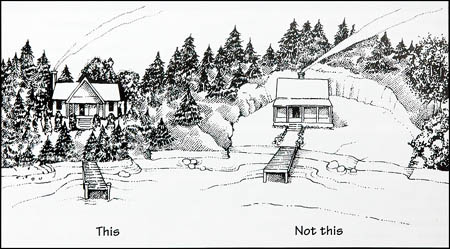The Importance of Buffer Strips
Vegetated phosphorus buffer strips are areas of natural vegetation that have been left undisturbed or are replanted to naturally existing species. These vegetative buffer strips are composed of trees, shrubs and a thick duff layer (pine needles, bark mulch, etc.).
Why Do We Need Them?
Where there are humans, there is nutrient pollution. The way we live tends to over-nourish and pollute our environment. Fertilizers, oils and greases from our cars and boats, and heavy vehicle and foot traffic near the shores, all hurt our lakes.Vegetated buffers provide a filter and percolation area for the runoff that comes from our home and play areas. The vegetation in the buffer uses the nutrients carried in the storm water. If the nutrients reach the lake, the aquatic plants will use them and an algae bloom can occur, diminishing water quality.
Where Should They Be Located?
Vegetated buffers need to be placed between people and the lakes and streams. We need to filter the storm water run-off from our houses, garages, driveways, roads (both paved and gravel) and road ditches through flat, vegetated areas. Lakeside parking area and playing fields should drain through a buffer too.

How To Make a Buffer
- Leave the depressions and irregularities in your lawn. Don’t grade it directly into the lake.
- Don’t mow down to the edge of the lake. Leave as much shrub and tree growth as possible between the lawn and the lake.
- If you have flat, wet spots on your property, use them as a filter. Direct run-off through them and allow them to grow naturally.
- For new construction, minimize the amount of roof, driveway and parking area, as well as other impervious surfaces.
- Minimize bare areas by defining and limiting your parking area, beach area and foot paths. Keep foot paths to the lake under six feet wide and winding. Stabilize heavily trafficked areas with wood chips, bark mulch or some of the newer erosion-control materials.
- Tell family and visitors about why it’s important to protect the vegetation.
Planting a Vegetation Buffer
- Select a variety of trees, shrubs and ground covers to be used in your buffers. To make the best choice, look at what is already growing in your area and try to replace it.
- In areas where the view of the lake is desired, the predominant plants can be shrubs, but keep the opening in the tree canopy small.
- When you eliminate trees, you also reduce the quality of the buffer for deflecting raindrops and taking up nutrients.
- The natural duff layer that occurs in a forest needs to be replaced also. A thick layer of mulch material can be used.
- Width: Buffers range in width from 25 feet to 250 feet – make yours are wide as possible.
- Grading: In general, leave the buffer as irregular as possible.
- Footpaths: Foot traffic to the lake through the buffer should be limited to winding path four to six feet wide at the maximum. Stabilize the footpath with bark mulch or a similar controller.